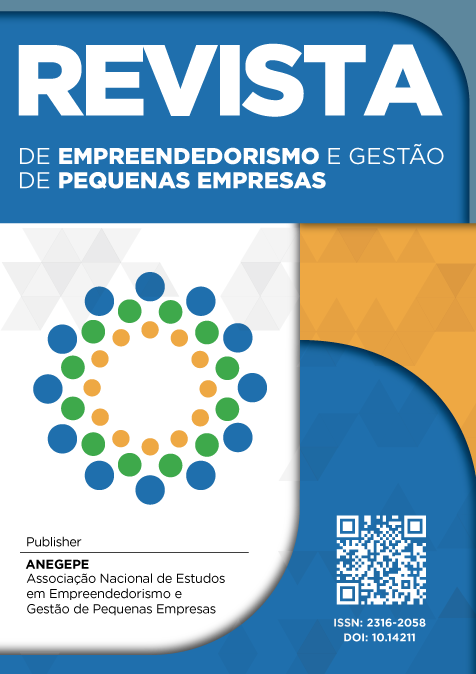I want to export but where to? A proposed method for selecting international markets
DOI:
10.14211/regepe.e1945Keywords:
Selection of international markets, International market segmentation, internationalization of companiesAbstract
Objective: to develop a suitable method for selecting international markets in order to meet firms’ needs. Methodology/approach: this is a technological paper, which has established a target market in Africa, with great potential for attractiveness and accessibility. Therefore, the ranking method, preceded by a cut-off line (clustering) of countries that did not meet minimum requirements, was applied through the decision matrix tool. Main results: the market selection started with the definition of the African continent and the 49 clustered countries, and then the unattractive ones were excluded, resulting in South Africa, Angola, Algeria, Egypt and Morocco. After applying ranking, Angola was the target market chosen for export. Theoretical/methodological contributions: the contribution is made through the use of a blend of methods – clustering and ranking – to select the target market, according to objective criteria. Relevance/originality: in view of the existing international market selection models, the proposed method stands as an improvement, as it brings two differentials – clustering as a cut-off line and the decision matrix as a tool for ranking countries. Managerial contributions: the indication of a simple and accessible method, capable of contemplating the specificity of attractiveness and accessibility of a given product, with the selection of international markets based on objective and not merely intuitive criteria, in order to increase its assertiveness.
JEL CODE: M16
Downloads
References
Al Qur’an, M. (2020). Success factors influencing the selection of the location of international firms. Competitiveness Review: An International Business Journal, 30(5), 665-679. https://doi.org/10.1108/CR-05-2018-0030
Apex-Brasil. (2018). Painéis de Inteligência de Mercado. Agência Brasileira de Promoção de Exportação e Investimentos. Recuperado de https://paineisdeinteligencia.apexbrasil.com.br/#
Carneiro, J., & Dib, L. A. (2007). Avaliação comparativa do escopo descritivo e explanatório dos principais modelos de internacionalização de empresas. Revista Eletrônica de Negócios Internacionais (Internext), 2(1), 1-25. http://doi.org/10.18568/1980-4865.211-25
Cavusgil, S. T., Kiyak, T., & Yeniyurt, S. (2004). Complementary approaches to preliminary foreign market opportunity assessment: Country clustering and country ranking. Industrial Marketing Management, 33(7), 607-617. https://doi.org/10.1016/j.indmarman.2003.10.005
Cavusgil, S. T., Knight, G., Riesenberger, J. R., Rammal, H. G., & Rose, E. L. (2014). International business: The new realities. Melbourne, Australia: Pearson.
Centro Internacional de Negócios (CIN/RS). [2021]. Home. Recuperado de https://www.fiergs.org.br/servicos/centro-internacional-de-negocios-cinrs
Jardon, C. M. (2018). Location and competitiveness in subsistence small businesses. Competitiveness Review: An International Business Journal, 28(2), 155-171. https://doi.org/10.1108/CR-11-2016-0075
Koch, A. J. (2001). Selecting overseas markets and entry modes: two decision processes or one? Marketing Intelligence & Planning, 19(1), 65-75. https://doi.org/10.1108/02634500110366120
Nunes, M. P., & Lequain, L. de S. (2017). A utilização da inteligência competitiva na seleção de mercados para exportação: Uma análise comparativa de quatro métodos. Internext, 11(3), 22-35. http://doi.org/10.18568/1980-4865.11322-35
Oviatt, B. M., & McDougall, P. P. (2005). Defining international entrepreneurship and modeling the speed of internationalization. Entrepreneurship theory and practice, 29(5), 537-553. https://doi.org/10.1111%2Fj.1540-6520.2005.00097.x
Ozturk, A., Joiner, E., & Cavusgil, S. T. (2015). Delineating foreign market potential: A tool for international market selection. Thunderbird International Business Review, 57(2), 119-141. https://doi.org/10.1002/tie.21686
Papadopoulos, N., Chen, H., & Thomas, D. R. (2002). Toward a tradeoff model for international market selection. International Business Review, 11(2), 165-192. https://doi.org/10.1016/S0969-5931(01)00054-3
Papadopoulos, N., & Martín, O. M. (2011). International market selection and segmentation: perspectives and challenges. International Marketing Review, 28(2), 132-149. https://doi.org/10.1108/02651331111122632
Ramadani, V., Zendeli, D., Gerguri-Rashiti, S., & Dana, L. P. (2018). Impact of geomarketing and location determinants on business development and decision making. Competitiveness Review: An International Business Journal, 28(1), 98-120. https://doi.org/10.1108/CR-12-2016-0081
Rocha, A., Ferreira, J. B., & da Silva, J. F. (2012). Administração de marketing: conceitos, estratégias, aplicações. São Paulo: Atlas.
Schu, M., & Morschett, D. (2017). Foreign market selection of online retailers – A path-dependent perspective on influence factors. International Business Review, 26(4), 710-723. https://doi.org/10.1016/j.ibusrev.2017.01.001
Sousa, C. M., & Bradley, F. (2005). Global markets: does psychic distance matter? Journal of Strategic Marketing, 13(1), 43-59. https://doi.org/10.1080/0965254042000328668
The World Factbook. (2014). Explore All Countries. Recuperado de https://www.cia.gov/the-world-factbook/countries/
Tran, H. T. (2019). Institutional quality and market selection in the transition to market economy. Journal of Business Venturing, 34(5), 105890. https://doi.org/10.1016/j.jbusvent.2018.07.001
Downloads
Published
Métricas
Visualizações do artigo: 1813 PDF (Português (Brasil)) downloads: 54 PDF downloads: 155
How to Cite
Issue
Section
License
Copyright (c) 2021 Beatrice Maria Zanellato Fonseca Mayer, Pâmela Martini, Rejane Roecker

This work is licensed under a Creative Commons Attribution 4.0 International License.
Authors who publish in this journal agree to the following terms:
-
The author(s) authorize the publication of the text in the journal;
-
The journal is not responsible for the opinions, ideas, and concepts expressed in the texts, as they are the sole responsibility of their authors;
-
Authors retain copyright and grant the journal the right of first publication, with the work published under the CC BY 4.0
License, which allows sharing the work with acknowledgment of authorship and initial publication in this journal;
-
Authors are allowed and encouraged to post their work (Submitted version, Accepted version [Manuscript accepted by the author], or Published version [Record version]) online, for example in institutional repositories or preprints, as it can lead to productive exchanges as well as earlier and greater citation of published work. REGEPE requires that authors indicate/link the published article with DOI. See the Effect of Open Access.















